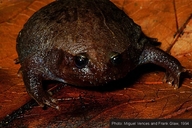|
Description
Up to 45 mm, M 33-39 mm. Tympanum distinct, greater than eye size. Eyes small. Tibiotarsal articulation reaches the tympanum. Finger 2 slightly longer than finger 4. Short barbels on the lower lip. Skin of the back with convergent longitudinal rows of tubercles. Dorsum red brown to blackish. Ventral surface less pigmented. Calling males with a very large vocal sac (Glaw and Vences 2007).
Similar species: R. coudreaui has no barbels on the lower lip (Glaw and Vences 2007).
Distribution and Habitat
Country distribution from AmphibiaWeb's database: Madagascar
Occurs in Sambava-Andapa, Nosy Be, Nosy Komba (Glaw and Vences 2007) from sea level up to 300m asl (Nussbaum et. al 2008).
Life History, Abundance, Activity, and Special Behaviors
Habits: Largely fossorial, only during heavy rain on the forest floor. Inhabits burrows under leaf litter in primary and secondary forest. Highest calling intensity just before and during heavy rain (day and night). Excavated juveniles and adults can show a defence position with stretched hindlimbs and concave dorsum. Two adults together with 18 juveniles of 9-11 mm were found under a big stone in a burrow in December, indicating parental care (Glaw and Vences 2007).
Calls: Single notes of low frequency, resembling the mooing of a cow (Glaw and Vences 2007).
Trends and Threats
This species is listed as vulnerable because it is only known from two localities (Nussbaum et. al 2008). Though it occurs in a protected area, the R�serve Naturelle Int�grale de Lokobe, its forest habitat is receding because of subsistence agriculture (including livestock grazing), timber extraction, charcoal manufacture, fire, and expanding human settlements (Nussbaum et. al 2008). Possible reasons for amphibian decline General habitat alteration and loss
Habitat modification from deforestation, or logging related activities
Intensified agriculture or grazing
Urbanization
Comments
Taken with permission from Glaw and Vences (2007) and Nussbaum et. al (2008).
References
Glaw, F., and Vences, M. (2007). Field Guide to the Amphibians and Reptiles of Madagascar. Third Edition. Vences and Glaw Verlag, Köln.
Nussbaum, R., Raxworthy, C., Andreone, F., Glaw, F., and Vences, M. (2008). Rhombophryne testudo. In: IUCN 2008. 2008 IUCN Red List of Threatened Species. www.iucnredlist.org. Downloaded on 14 April 2009.
Originally submitted by: Miguel Vences and Frank Glaw (first posted 2001-10-26)
Edited by: Catherine Aguilar (2010-07-19)Species Account Citation: AmphibiaWeb 2010 Rhombophryne testudo <https://amphibiaweb.org/species/2359> University of California, Berkeley, CA, USA. Accessed Jun 6, 2025.
Feedback or comments about this page.
Citation: AmphibiaWeb. 2025. <https://amphibiaweb.org> University of California, Berkeley, CA, USA. Accessed 6 Jun 2025.
AmphibiaWeb's policy on data use.
| 